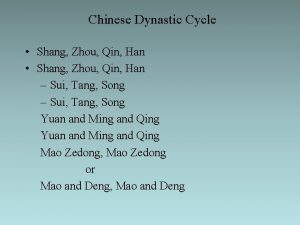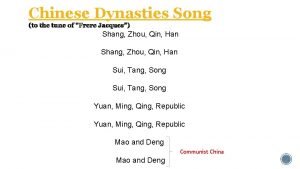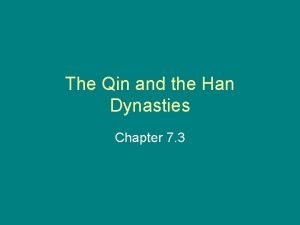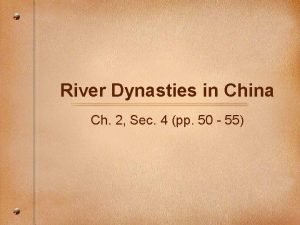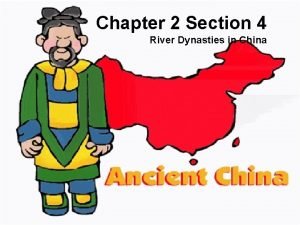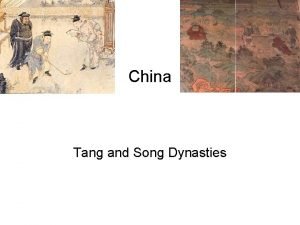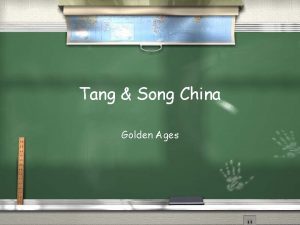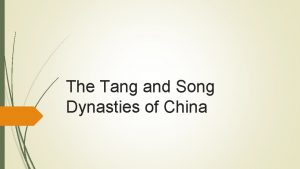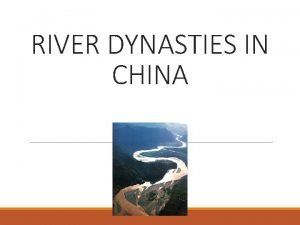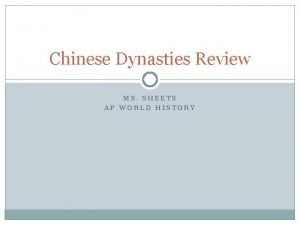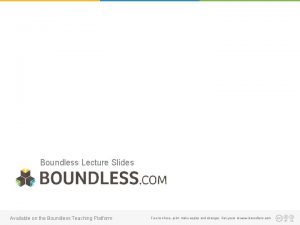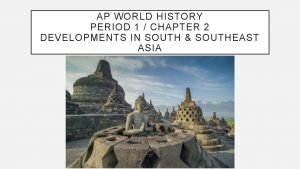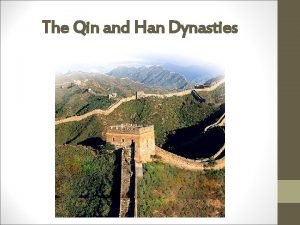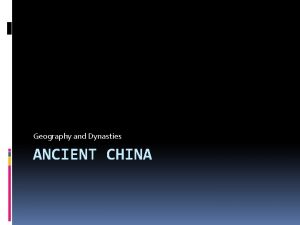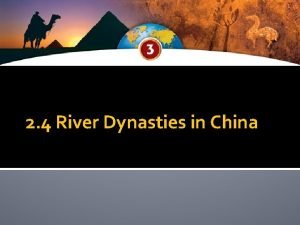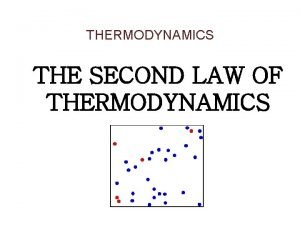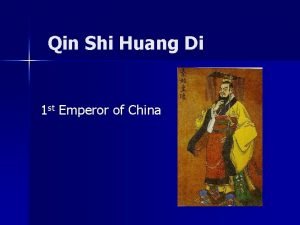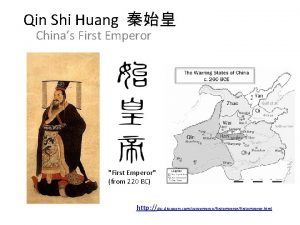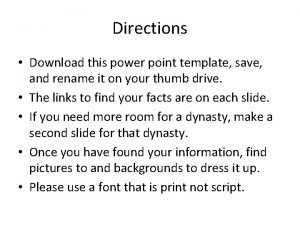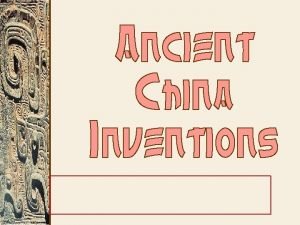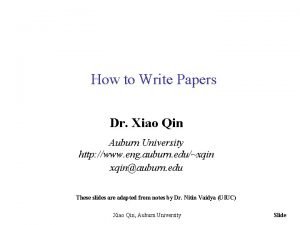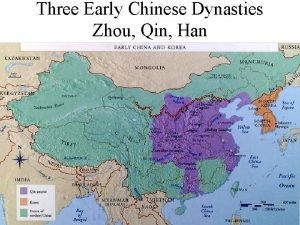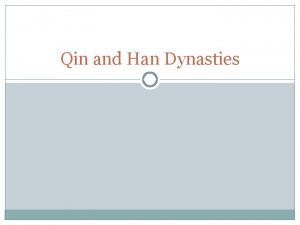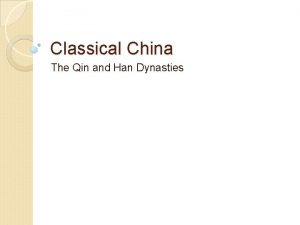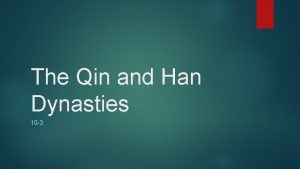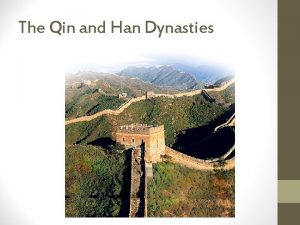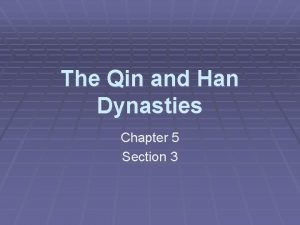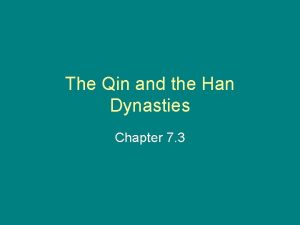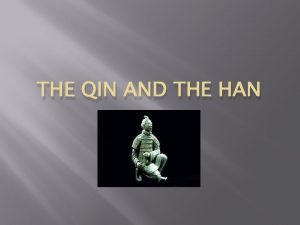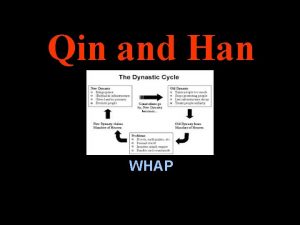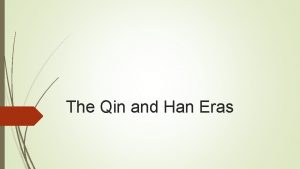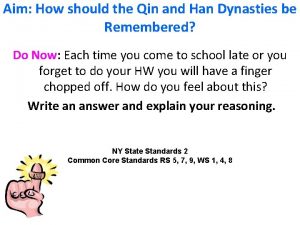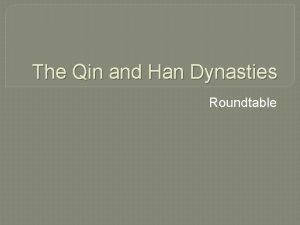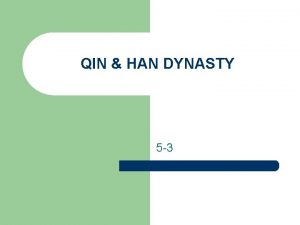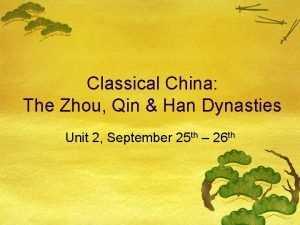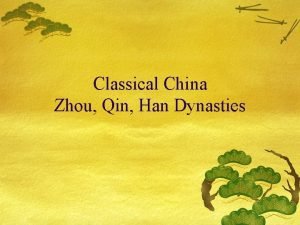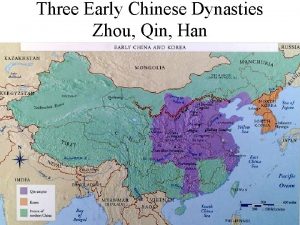The Qin and the Han Dynasties Chapter 7

































- Slides: 33

The Qin and the Han Dynasties Chapter 7. 3

Objectives • 6. 35 List the policies and achievements of the emperor Shi Huang and explain how these contributed to the unification of northern China under the Qin Dynasty and the construction of the Great Wall of China. (H, P) • 6. 36 Detail the political contributions of the Han Dynasty and determine how they contributed to the development of the imperial bureaucratic state and the expansion of the empire. (H, P) • 6. 37 Cite the significance of the trans-Eurasian “silk roads” in the period of the Han Dynasty and Roman Empire and their locations. (E, G, H) • 6. 38 Describe the diffusion of Buddhism northward to China during the Han Dynasty

The Qin Emperor • Qin controlled China from the Huang He to the Chang Jiang • Qin Shihuangdi means “the First Qin Emperor”

How Did Qin Change China? • Qin wanted to strengthen and unify China • Ruled with absolute control and punishment – Anyone who disagreed was punished and killed – Writings that displeased Qin were burned

Qin created currency or money

Writing system • Simplified and set rules for writing system

Shi Huangdi’s tomb • In March of 1974, Chinese peasants digging a well near Xi'an in the central province of Shaanxi found some unusual pottery fragments. Then, deeper down at eleven feet, they unearthed a head made of terra cotta (baked earth or clay). They notified the authorities and excavation of the site began immediately. To date, workers have dug up about eight thousand sculpted clay soldiers, and the site has proved to be one of the greatest archaeological discoveries of all time.

Terra Cotta Soldiers

Grand Canal • Shi Huangdi built a canal that connected Chang Jiang ito the Guangzhou in Southern China

Why was the Great Wall Built? • To keep out invaders

The Great Wall Facts • • • The Great Wall of China was built over about 2000 years by several different Chinese emperors, starting in BC 475, to protect the people from their enemies, the Huns. Facts about building and the construction of the great wall of china. The Wall is a unique structure that is considered one of the seven wonders of the world. It snakes through the mountains of China for 4, 500 miles. That's longer than the distance across from New York to California by about 1, 000 miles! Many small walls were constructed by multiple Chinese emperors. Most of these small walls no longer exist as they were revamped during the Ming Dynasty, between 1368 and 1644 A. D. , while much of the rest of the world was still developing. The Ming Dynasty's rebuilding made it more elaborate with watchtowers, battlements and cannons. Leading the great wall to additional protection of the people. • The Great Wall is 25 feet tall and 15 -30 feet wide. That's wide enough for two cars to drive on! The facts show many people worked to build the Great Wall of China. Ancient records show that more than 300, 000 soldiers and 500, 000 commoners worked to build it. That's about the same as the population of San Francisco! Building the wall was hard work. Some of it was in very hot weather and some in the bitter cold. In the earliest stages, builders rammed earth and stone into the walls. But in the Ming Dynasty they used bricks, limestone and tiles, as well. • • http: //www. airpano. ru/files/China-Great-Wall/2 -2 http: //www. panoramas. dk/7 -wonders/great-wall. html

The End of Qin Rule • Qin boasted that his dynasty would rule China forever • Both aristocrats and farmers revolted against harsh Qin rule

Han Rulers • In 202 B. C. Liu Bang founded the Han Dynasty – Liu Bang was a farmer turned soldier – Started the Han Dynasty that lasted 400 years

Han Wudi • Ruled from 141 B. C. -87 B. C. • Recruited people for civil service – People were chosen on the basis of competitive tests – Raised the quality of government – Favored the rich-only rich could afford education

Education • Han created schools – Studied law, history, and ideas of Confucius – Well respected because of education

The Empire Expands • Population rose to 60 million • Farmers sold land became tenant farmers • Han Empire took new territory • Conquered Korea, Southeast Asia, northern India • Chinese had peace for 150 years

Han Culture • Ideas of Confucius gained influence • Filial piety became strong • Stability of government strengthen family ties

Chinese Inventions • Cast-iron plow

Waterwheels • Millers invented waterwheels to grind grain

Wheelbarrow • Wheelbarrow-used to carry heavy material •

Silk Manufacturing

Paper • Paper used for wrapping and writing

Toilet Paper • Also invented toilet paper

Rudder • Rudder and the wind a new way to move the sails of ships – With these inventions, ships could sail against

Medical Advances • Certain foods prevented disease • Used herbs to treat illnesses

Acupuncture • Acupuncture-relieved pain by piercing patients’ skin at vital points with thin needles • Renews the body by increasing flow of energy

On the Silk Road • During the Han period, Chinese traders grew rich

New Contacts with the West • China’s trade increased as a result of exploration – Zhang Qian explored areas west of China • Found horses • Han Wudi wanted horses for soldiers • In exchange for horses, Chinese traded silk

Trade expands • Silk road was not one road. It was a network of trade routes • 4, 000 miles long • Stretched from China to Mediterranean Sea

Goods Traded • Horses, silk, spices, fruits, vegetables, flowers, and grains, peaches, pears, cotton, paper etc… • https: //www. youtube. com/watch? v=vfee. Nq-Qyg

Buddhism Reaches China • Silk Road spread knowledge, culture, and religions. • Buddhism spread along Silk Road from India to China

Why Did the Han Dynasty Collapse? • Weak and dishonest emperors • Corrupt officials • People began to rise up and rebel against Han rulers • Civil war divided China • Remained divided for 400 years

Buddhism Wins Followers • Civil War frightened many Chinese • Many people turned to Buddhist ideas • Followers of Confucius and Daoists admired Buddhist ideas • By A. D. 400 s Buddhism became one of China’s major religions
 Shang zhou qin han song
Shang zhou qin han song Shang zhou qin han song
Shang zhou qin han song Qin han
Qin han River dynasties in china
River dynasties in china Social classes in song dynasty
Social classes in song dynasty Golden ages of china tang and song dynasties
Golden ages of china tang and song dynasties Sui dynasty contributions
Sui dynasty contributions Golden age of tang and song dynasties
Golden age of tang and song dynasties Han sui tang song
Han sui tang song Sui tang and song dynasties
Sui tang and song dynasties How did the sui and tang dynasties reunite china
How did the sui and tang dynasties reunite china Why were the tang and song dynasties golden ages
Why were the tang and song dynasties golden ages Achievements of the tang and song dynasties
Achievements of the tang and song dynasties Conclusion of tughlaq dynasty
Conclusion of tughlaq dynasty Chinese dynasties acrostic poem
Chinese dynasties acrostic poem Empress wu accomplishments
Empress wu accomplishments River dynasties in china
River dynasties in china Fsebo
Fsebo Ap world history chinese dynasties
Ap world history chinese dynasties Chinese dynasties
Chinese dynasties Srivijaya empire definition ap world history
Srivijaya empire definition ap world history Four chinese dynasties
Four chinese dynasties Zhou dynasty geography
Zhou dynasty geography China history timeline
China history timeline River dynasties in china
River dynasties in china Wnet = qin - qout
Wnet = qin - qout Qin shi huang quotes
Qin shi huang quotes Qin shi huang ror
Qin shi huang ror Zhou dynasty facts
Zhou dynasty facts The han dynasty inventions
The han dynasty inventions Xiao qin auburn
Xiao qin auburn Wnet = qin - qout
Wnet = qin - qout Qin writing system
Qin writing system Qin writing system
Qin writing system
